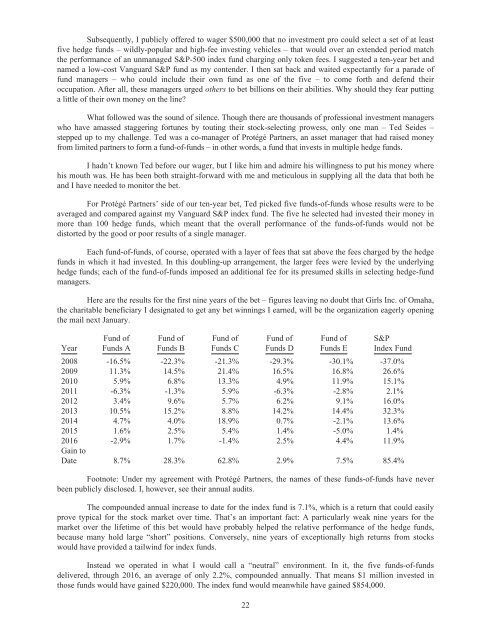Berkshire’s Performance vs the S&P 500 2
gnjtA93
gnjtA93
You also want an ePaper? Increase the reach of your titles
YUMPU automatically turns print PDFs into web optimized ePapers that Google loves.
Subsequently, I publicly offered to wager $<strong>500</strong>,000 that no investment pro could select a set of at least<br />
five hedge funds – wildly-popular and high-fee investing vehicles – that would over an extended period match<br />
<strong>the</strong> performance of an unmanaged S&P-<strong>500</strong> index fund charging only token fees. I suggested a ten-year bet and<br />
named a low-cost Vanguard S&P fund as my contender. I <strong>the</strong>n sat back and waited expectantly for a parade of<br />
fund managers – who could include <strong>the</strong>ir own fund as one of <strong>the</strong> five – to come forth and defend <strong>the</strong>ir<br />
occupation. After all, <strong>the</strong>se managers urged o<strong>the</strong>rs to bet billions on <strong>the</strong>ir abilities. Why should <strong>the</strong>y fear putting<br />
a little of <strong>the</strong>ir own money on <strong>the</strong> line?<br />
What followed was <strong>the</strong> sound of silence. Though <strong>the</strong>re are thousands of professional investment managers<br />
who have amassed staggering fortunes by touting <strong>the</strong>ir stock-selecting prowess, only one man – Ted Seides –<br />
stepped up to my challenge. Ted was a co-manager of Protégé Partners, an asset manager that had raised money<br />
from limited partners to form a fund-of-funds – in o<strong>the</strong>r words, a fund that invests in multiple hedge funds.<br />
I hadn’t known Ted before our wager, but I like him and admire his willingness to put his money where<br />
his mouth was. He has been both straight-forward with me and meticulous in supplying all <strong>the</strong> data that both he<br />
and I have needed to monitor <strong>the</strong> bet.<br />
For Protégé Partners’ side of our ten-year bet, Ted picked five funds-of-funds whose results were to be<br />
averaged and compared against my Vanguard S&P index fund. The five he selected had invested <strong>the</strong>ir money in<br />
more than 100 hedge funds, which meant that <strong>the</strong> overall performance of <strong>the</strong> funds-of-funds would not be<br />
distorted by <strong>the</strong> good or poor results of a single manager.<br />
Each fund-of-funds, of course, operated with a layer of fees that sat above <strong>the</strong> fees charged by <strong>the</strong> hedge<br />
funds in which it had invested. In this doubling-up arrangement, <strong>the</strong> larger fees were levied by <strong>the</strong> underlying<br />
hedge funds; each of <strong>the</strong> fund-of-funds imposed an additional fee for its presumed skills in selecting hedge-fund<br />
managers.<br />
Here are <strong>the</strong> results for <strong>the</strong> first nine years of <strong>the</strong> bet – figures leaving no doubt that Girls Inc. of Omaha,<br />
<strong>the</strong> charitable beneficiary I designated to get any bet winnings I earned, will be <strong>the</strong> organization eagerly opening<br />
<strong>the</strong> mail next January.<br />
Year<br />
Fund of<br />
Funds A<br />
Fund of<br />
Funds B<br />
Fund of<br />
Funds C<br />
Fund of<br />
Funds D<br />
Fund of<br />
Funds E<br />
S&P<br />
Index Fund<br />
2008 -16.5% -22.3% -21.3% -29.3% -30.1% -37.0%<br />
2009 11.3% 14.5% 21.4% 16.5% 16.8% 26.6%<br />
2010 5.9% 6.8% 13.3% 4.9% 11.9% 15.1%<br />
2011 -6.3% -1.3% 5.9% -6.3% -2.8% 2.1%<br />
2012 3.4% 9.6% 5.7% 6.2% 9.1% 16.0%<br />
2013 10.5% 15.2% 8.8% 14.2% 14.4% 32.3%<br />
2014 4.7% 4.0% 18.9% 0.7% -2.1% 13.6%<br />
2015 1.6% 2.5% 5.4% 1.4% -5.0% 1.4%<br />
2016 -2.9% 1.7% -1.4% 2.5% 4.4% 11.9%<br />
Gain to<br />
Date 8.7% 28.3% 62.8% 2.9% 7.5% 85.4%<br />
Footnote: Under my agreement with Protégé Partners, <strong>the</strong> names of <strong>the</strong>se funds-of-funds have never<br />
been publicly disclosed. I, however, see <strong>the</strong>ir annual audits.<br />
The compounded annual increase to date for <strong>the</strong> index fund is 7.1%, which is a return that could easily<br />
prove typical for <strong>the</strong> stock market over time. That’s an important fact: A particularly weak nine years for <strong>the</strong><br />
market over <strong>the</strong> lifetime of this bet would have probably helped <strong>the</strong> relative performance of <strong>the</strong> hedge funds,<br />
because many hold large “short” positions. Conversely, nine years of exceptionally high returns from stocks<br />
would have provided a tailwind for index funds.<br />
Instead we operated in what I would call a “neutral” environment. In it, <strong>the</strong> five funds-of-funds<br />
delivered, through 2016, an average of only 2.2%, compounded annually. That means $1 million invested in<br />
those funds would have gained $220,000. The index fund would meanwhile have gained $854,000.<br />
22


